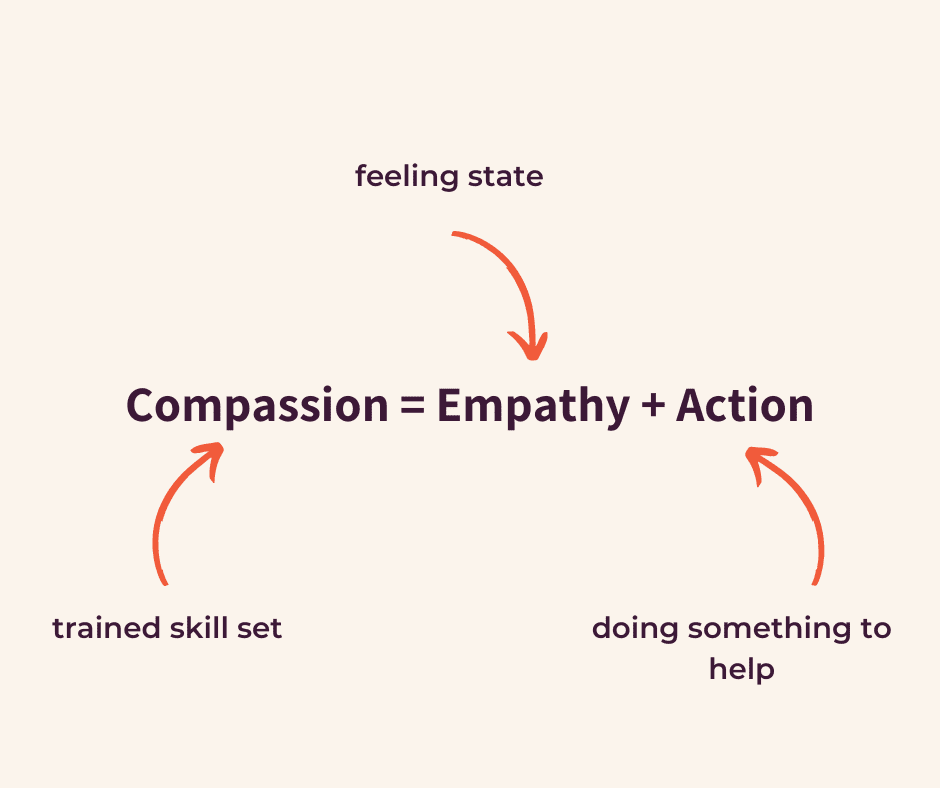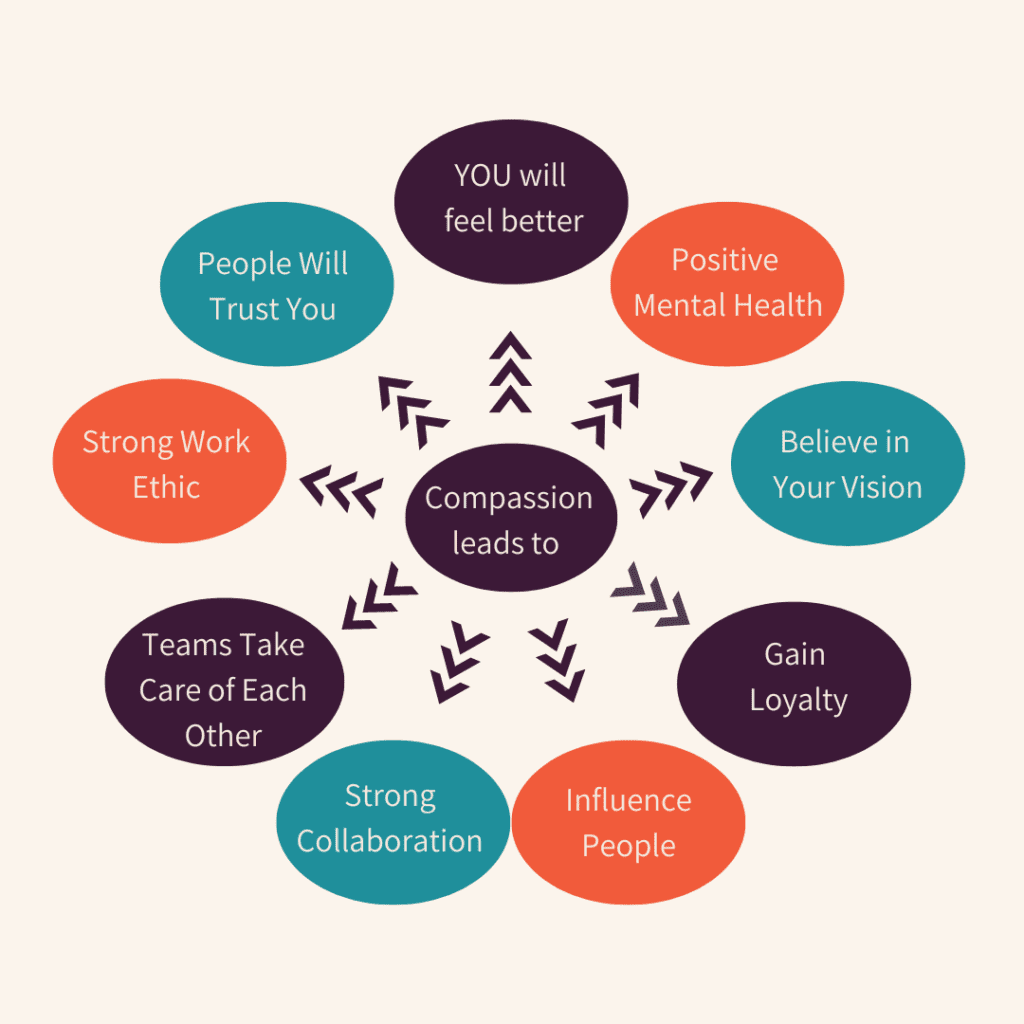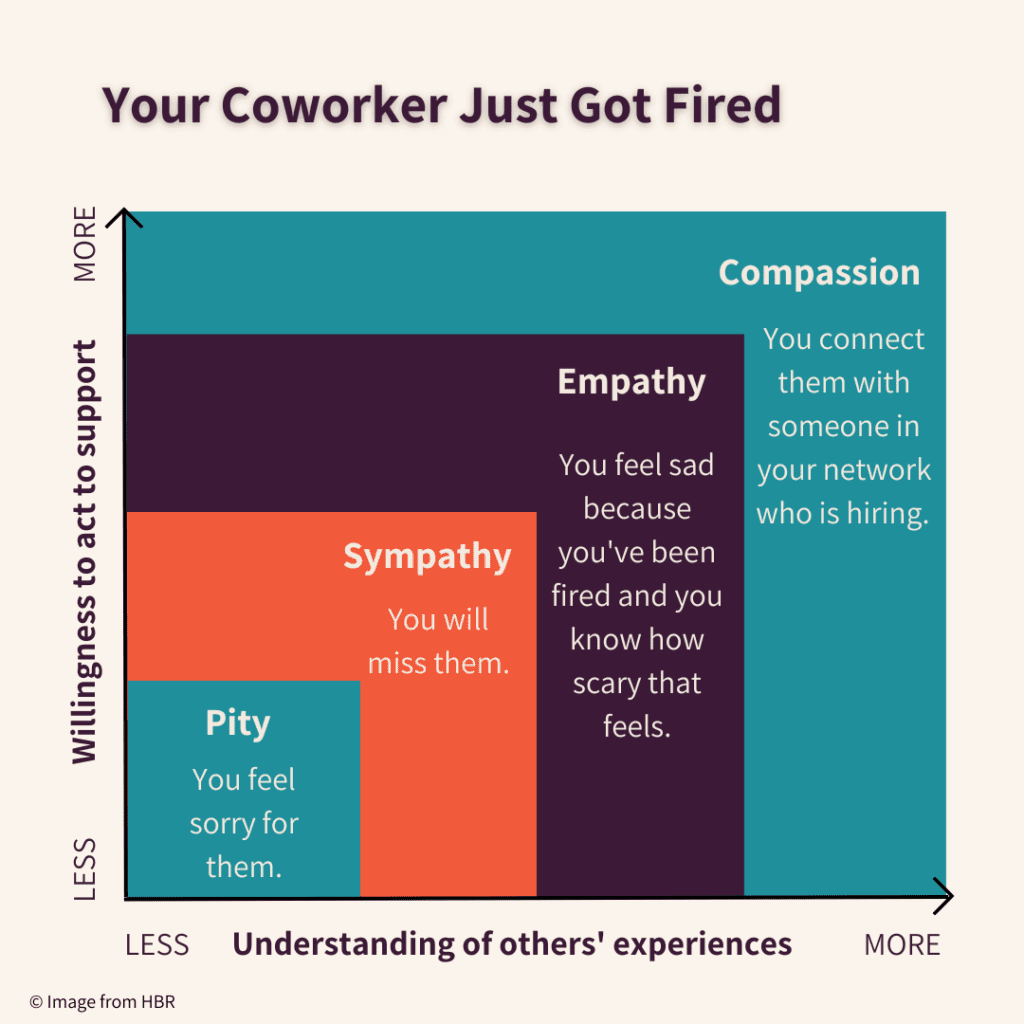
Summary. Learn how to lead with compassion at work through actionable tasks. Develop realistic expectations and decrease frustration around compassionate leadership.
Definition of a Leader- someone who has the ability to influence and change behavior.
This definition states “someone” who has the ability to influence and change behavior. This someone could be your friend, child, parent, teacher, neighbor, manager, or dentist. If your dentists can convince you to floss more regularly, they are a leader. This is not exclusive to the C-Suite leadership team at your company. Anyone can be a leader if they have the ability to influence or change behavior.
Definition of Compassion– the feeling that arises when you are confronted with another’s pain and feel motivated to relieve that pain.
Compassion is not sympathy or empathy. Empathy is the ability to relate to another person’s pain as if it’s your own. Empathy, like sympathy, is grounded in emotion and feeling, but empathy doesn’t have an active component to it. Compassion gets involved.

IS COMPASSION SOMETHING WE CAN LEARN?

YES! The answer is definitive yes, compassion is both innate and can be learned and enhanced. Advances in neuroscience have shown us that the human brain has neural networks that are hard-wired with the ability to share the experiences of others, including emotions and sensations.
Compassion is something I learned the hard way. I have siblings but grew up as an only child. If I was thirsty, I would walk into the kitchen and grab a glass of water for myself. I didn’t need to think about anyone else.
Ten years later I am having dinner with coworkers at a restaurant. I walk up to the counter and get a glass of water for myself. One coworker, Tiffany, kindly educated me on “expanding my view” beyond my own needs. This was the beginning of my education in compassion, and also the start of a very long friendship with Tiffany.
WHY MAKE LEADING WITH COMPASSION A PRIORITY?
New data suggests that for almost 70% of people, their work environment has more impact on their mental health than their therapist or their doctor—and it’s equal to the impact of their partner. If you’re a leader, you’re right to find this data sobering.
Compassion is the most undervalued leadership skill for optimal team performance. It’s an essential relationship-building quality that impacts our performance, mental health, and emotional well-being. Compassion is part of our genetic makeup-and it’s easy to practice once we know what it is.
Here are some benefits of prioritizing compassionate leadership:

A compassionate leader will foster an atmosphere of trust. This will lead to a work culture of transparency. If people feel that they can be honest with their views and concerns without fear of recrimination, there will be much easier communication at work. This leads to less friction and higher levels of productivity.
MYTHS ABOUT LEADING WITH COMPASSION

Leadership is a human capacity, not a position. It’s a gift, talent, and skill. Leaders must be willing to dig into the humanity of this work. Otherwise, they won’t make progress in developing employees and finding common ground that builds trust, cultivates critical thinking, inspires innovation, and protects mental health. Common myths must be addressed to ensure people see the value of compassionate leadership. These myths include:
- Compassionate leaders get too close to those around them.
- Loss of commitment to purpose and high-quality performance.
- Tough performance management and conversations won’t be allowed or will be labeled as bullying.
- Always taking the easy, consensus way forward rather than putting clients and communities first.
- Compassionate leaders focus on making everyone happy.
- Not being able to challenge the status quo and make the radical changes our clients and communities need.
- Teamwork and system working will be controlled by whoever has the most power and is most ruthless.
- Compassionate leaders are too sensitive or “too nice.”
- Compassion is something we are born with. Some have it, some don’t.
If you believe some of these statements, you’re not alone. Unfortunately, some people today still view leadership as a position of authority that comes with a title and power over others. Compassionate leadership is inherent in all of us. In path to expanding on this skill set starts with self-awareness.
Test Your Compassion Toward Others
This test finds out how sensitive you are to others’ emotions and how well you can gauge feelings or emotions which might be left unsaid.
How Compassionate Are You Towards Others Test
COMPASSION DISORDERS

It’s easy for some to take action when they feel empathy, but that’s not the case for everyone. Here are some scenarios where people can have trouble leading with compassion:
- Hyper-Empathy Syndrome
- Narcissistic Personality Disorder (NPD)
- Empathy-Deficit Disorder
- Antisocial Personality Disorder (ASPD)
- Borderline Personality Disorder (BPD)
Hyper-Empathy Syndrome

People with hyper-empathy syndrome have strong emotional reactions when other people experience negative feelings. Sometimes, these reactions are intense even if they’re only looking at a photo or watching a movie. Symptoms may include physical pain like a stomach ache and nausea. They may still feel an emotional response to another person’s pain a few days after it happened.
These people feel overwhelmed after talking to people about their problems because it’s as if they’re happening to them. They’re so focused on other people’s problems that they neglect taking care of themselves. They also find it hard to say no to people because they feel sorry for them.
Narcissistic Personality Disorder (NPD)

Five common signs of narcissism include an inflated sense of self, a constant need for attention, self-centeredness, lack of empathy, and preoccupation with power and success. Some of the symptoms associated with NPD include a genuine belief that they are unique or special and should only associate with other people of the same status. There is often an exaggerated sense of one’s own abilities and achievements. There is also a constant need for attention, affirmation, and praise.
People with NPD may also exploit other people for personal gain. They may feel envious of others or believe that others are envious of them. This ties to a sense of entitlement and expectation of special treatment.
Empathy-Deficit Disorder
People with empathy deficit disorder tend to focus on their own needs and neglect other people’s emotions, even those of close friends and family. They struggle to build and maintain emotional connections. They can be overly judgemental of others and underestimate what others are going through. Because of this, they don’t usually show appreciation or gratitude. The struggle to relate to others prevents them from understanding people with different cultural, political, or religious backgrounds.
EXAMPLES OF HOW TO LEAD WITH COMPASSION
Compassion is both innate and can be learned and enhanced. Advances in neuroscience have shown us that the human brain has neural networks that are hard-wired with the ability to share the experiences of others, including emotions and sensations. Compassion goes beyond sympathy and empathy. The component of action is what separates compassion from empathy, sympathy, pity, concern, condolence, sensitivity, tenderness, commiseration, or any other compassion synonym.
Compassion gets involved. Instead of keeping our distance from those who are suffering, compassion prompts us to act toward alleviating their suffering.
- Pity- I feel sorry for you.
- Sympathy- I feel for you.
- Empathy- I feel with you.
- Compassion- I am here to help.
Compassion at Work
Tech companies have laid off over 70,000 people in the last year. Losing a job is one of the three major stressors in life, next to moving and having a child. If you know someone who has been laid off, this is an opportunity to lead with compassion.

Taking an opportunity to connect a former coworker with someone in your network is a great opportunity to lead with compassion. If you’ve ever had someone extend a helping hand, you know how good that feels. Sending an email to connect two people in your network is a perfect example of compassionate leadership.
Cancel Culture: Calling Out vs Calling In

Cancel culture is an example of toxic leadership that perpetuates personal and collective suffering. The practice of “canceling people” is exemplified in the public shaming of people online, at work, and in the media. Calling people out is the dirty underbelly of today’s leadership and influence. Calling people out is the opposite of leading with compassion. It is the ostracizing of people.
Calling in, on the other hand, involves leading with compassion. When calling someone in, you communicate with them in private, embracing empathy, and giving them a chance to process and reflect on their shortcomings. Calling someone in gives them the opportunity to respond with grace. Given such an opportunity, some people will course-correct, sincerely apologize, and make amends. Read more on this from DEI expert Dr Jana >>
Start Small
The act of compassion doesn’t have to be time-consuming or complicated. Here’s how you can take small steps toward compassionate leadership at work:
- Give someone a genuine compliment
- Say “thank you”
- Use your emojis on the zoom meeting to show that you are listening, or to express emotion
- Give credit to someone to acknowledge their value and show your appreciation
- Apologize when you’ve made a mistake
- Encourage other people
- Offer to help someone with a task
- Celebrate someone else’s success with them
- Forgive people for making mistakes
- Express gratitude and appreciation
PRACTICE COMPASSION
Compassion is not a gift you are born with, it’s a learned skill. Our brains have an incredible level of neuroplasticity, enabling us to develop almost any skill and get stronger and more prominently-displayed, over time. Listen to this 5 min Office Yoga compassion meditation. This meditation walks you through how to embody compassion, in action, right away. If you prefer no audio, follow the steps below.
Compassion Meditation (5 min)

- Set a timer for 5 minutes.
- Sit comfortably, relax, and focus your attention on your breath to let your mind settle.
- When you have centered yourself, recall a person dear to you, someone who is experiencing challenges.
- Be clearly aware of the challenges and how they must feel for the person experiencing them.
- With each exhale, imagine you breathe out everything this person needs: warmth, strength, and compassion. Breathe out everything that is positive and imagine it entering the other person.
- While you continue breathing compassion on each exhale, with each inhale, imagine removing all suffering, pain, regret, and hurt from the person — but without you taking it on. Imagine that you’re simply removing their pain.
- When you’re ready, let go of the person and return your attention to your breath.
- When you’re ready, let go of the practice and notice how you feel
In summary
Compassion is a learned skill we can cultivate through practice. Leading with compassion is the most undervalued contributor to optimal health and team performance. Through compassion, we can enhance trust, transparency, productivity, and mental health at work.
ZaaS | Zen as a Service offers yoga, meditation, and well-being services to B Corps and large companies worldwide. Join us!



